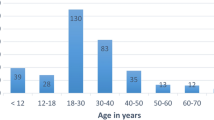Abstract
In the diagnosis of traumatic and nontraumatic emergencies, computed tomography (CT) is the most frequently performed procedure. The aims of this study were to find out whether CT report results can be used as a reliable tool for the diagnosis and management of patients at an emergency department and to evaluate the appropriateness of the selection criteria for CT examinations. For this reason, we analysed the emergency CT procedures according to the diagnostic hypothesis written on CT request forms, the results of the CT reports and the final diagnosis of the patients. One thousand consecutive CT procedures in the emergency department of a research hospital were retrospectively analysed. When the CT reports and the final diagnosis were evaluated, the sensitivity and specifity of the CT were found to be 0.81 and 0.85. According to the analysis of the CT reports, 55.8 % of all the patients were reported to be normal. When the patient files were examined for the final diagnosis of the patients, 55.7 % of the patients did not receive a final diagnosis related to the diagnostic hypothesis. The lowest correlation was found between the diagnostic hypothesis, the CT reports and the final diagnosis of the patients who underwent cranial CT procedure for trauma. The results of the CT reports can be used as a reliable parameter for the diagnosis and management of the patients at emergency departments. On the other hand, a high negative rate of CT reports was noted especially for the cranial CT examinations. CT selection criteria for the head trauma patients should be reconsidered. Since CT is a procedure involving ionising radiation, it is important that it is performed with the correct indications and the relevant clinical information is specified on the CT request forms.
Similar content being viewed by others
References
Harris JH Jr (2002) Reflections: emergency radiology. Radiology 218:309–316
Hauser H, Bohndorf K (1998) Radiologic emergency management in multiple trauma cases. Radiologe 38:637–644
Prokop M (2003) General principles of MDCT. Eur J Radiol 45:4–10
Philipp MO, Kubin K, Mang T, Hormann M, Metz VM (2003) Three-dimensional volume rendering of multidector-row CT data: applicable for emergency radiology. Eur J Radiol 48:33–38
Kligenbeck-Regn K, Schaller S, Flohr T, Ohnesorge B, Kopp AF, Baum U (1999) Subsecond multi-slice computed tomography: basics and applications. Eur J Radiol 31:110–124
Lee EY, Siegel MJ, Hildebolt CF, Gutierrez FR, Bhalla S, Fallah JH (2004) MDCT evaluation of thoracic aortic anomalies in pediatric patients and young adults: comparison of axial, multiplanar, and 3D images. AJR 182:777–784
Mahesh M (2002) Search for isotropic resolution in CT from conventional through multiple-row detector. RadioGraphics 22:949–962
Kelly DM, Hasegawa I, Borders R, Hatabu H, Boiselle PM (2004) High-resolution CT using MDCT: comparison of degree of motion artifact between volumetric and axial methods. AJR 182:757–759
Philipp MO, Kubin K, Hormann M, Metz VM (2003) Radiological emergency room management with emphasis on multidector row CT. Eur J Radiol 48:2–4
Leidner B, Adiels M, Aspelin P, Gullstrand P, Wallen S (1998) Standardized CT examination of the multitraumatized patient. Eur Radiol 8:1630–1638
Novelline RA, Rhea JT, Rao PM, Stuk JL (1999) Helical CT in emergency radiology. Radiology 213:321–339
Nunez DB Jr, Ledbetter MS, Farrell L (2002) Dedicated CT scanner in an emergency department: quantification of factors that contribute to lack of use. AJR 179:859–862
National Institute for Clinical Excellence (2002) Head injury in infants, children and adults: triage, assessment, investigation and early management (Nice guideline). December 2002 Second Consultation Draft, London
Stiell IG, Wells GA, Vandemheen K et al (2001) The Canadian CT head rule for patients with minor head injury. Lancet 357:1391–1396
Kay A, Teasdle G (2001) Head injury in the United Kingdom. World J Surg 25:1210–1220
Society of British Neuroradiological Surgeons (2000) Safe neurosurgery. A report from the society of British neuroradiological surgeons. In: Nelson MJ (ed) SBNS. Lincoln’s Fields, London, pp 35–43
Harris A, Williams D, Jain N, Lockey A (2006) Management of minor head injuries according to NICE guidelines and changes in the number of patients requiring computerised tomography imaging in a district general hospital: a retrospective study. Int J Clin Pract 60:1120–1122
Macgregor DM, Mckie L (2005) CT or not CT-that is the question. Whether it’s better to evaluate clinically and x ray than to undertake a CT head scan. Emerg Med J 22:541–543
Novak EM, Terabe F, Nasimoto AL et al (2001) Correlation between diagnostic hypothesis and result of cranial computed axial tomography. Arq Neuropsiquiatr 59:761–767
Teunen D (1998) The European directive on health protection of individuals against the dangers of ionising radiation in relation to medical exposures (97/43/EURATOM). J Radiol Prot 18:133–137
Walker A, Tuck JS (2001) The ionising radiation (medical exposure) regulations: impact on clinical radiology. Br J Radiol 74:571–574
Zacharia TT, Kanekar SG, Nguyen DT, Moser K (2011) Optimization of patient dose and image quality with z-axis dose modulation for computed tomography (CT) head in acute head trauma and stroke. Emerg Radiol 18:103–107
Ardley ND, Lau KK, Buchan K (2013) Radiation dose reduction using a neck detection algorithm for single spiral brain and cervical spine CT acquisition in the trauma setting. Emerg Radiol 20:493–497
Sierink JC, Saltzherr TP, Wirtz MR, Streekstra GJ, Beenen LF, Goslings JC (2013) Radiation exposure before and after the introduction of a dedicated total-body CT protocol in multitrauma patients. Emerg Radiol 20:507–512
Conflict of interest
The authors declare that they have no conflict of interest.
Author information
Authors and Affiliations
Corresponding author
Rights and permissions
About this article
Cite this article
Gunes Tatar, I., Aydin, H., Kizilgoz, V. et al. Appropriateness of selection criteria for CT examinations performed at an emergency department. Emerg Radiol 21, 583–588 (2014). https://doi.org/10.1007/s10140-014-1234-0
Received:
Accepted:
Published:
Issue Date:
DOI: https://doi.org/10.1007/s10140-014-1234-0




